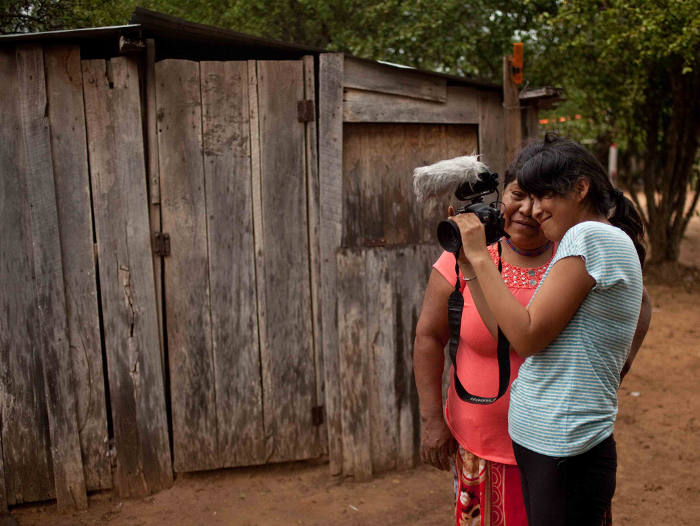-
|
15 July 2016
|Posteado en : Opinion
Marta García Moreno es la Coordinadora del proyecto Chaco Ra’anga en Paraguay, y hace un repaso de los objetivos, actividades y países visitados durante el proyecto.
Image of the Chaco
The Gran Chaco is a territory people imagine to be remote, isolated and impenetrable. A land of jaguars, dust, gigantic cacti, lagoons and alligators, it extends over Argentina, Paraguay, Bolivia, and a small slice of Brazil.
Numerous indigenous peoples with different ethnic identities coexist peacefully with other later-established communities, such as Creoles and Mennonites. In addition to the rich cultural diversity, the Chaco is a key area for conservation of biodiversity. However, the model of large-scale extractive development is a rapidly growing threat to the sustainability of the environment and the traditional ways of life of its peoples.
Chaco Ra’anga
Chaco comes the Quechua word chaku, meaning ‘hunting land’. Ra’anga is a Guaraní word that means reflection, image.
Chaco Ra’anga might be translated as ‘The Image of the Chaco’.
The journey
1 month (May, 2015)
3 countries (Argentina, Bolivia and Paraguay)
7 vans
27 people travelling with cameras and a great many questions
All of them full of good intentions, although this is not always sufficient.
“No one comes back from the Chaco (he who returns is, in part, a different person)”, Ticio Escobar. El círculo inconcluso, 2014.
For one month we toured the Chaco, observing large cotton and soybean fields in northern Argentina. The soybean fields continued into Bolivia, accompanied by hydrocarbon operations. Entering the Paraguayan Chaco, endless hectares of cattle ranches. We came into contact with indigenous communities that have been displaced from their ancestral lands and are fighting to recover their rights, not only territorial but also civil, political, economic, social and cultural.
Despite the environmental and cultural deforestation, we also get to see a Chaco that resists the encroachment of agriculture and livestock operations. There are alternative and sustainable development models that respect the environment, such as family farming, agro-ecology, and the ways of life of the indigenous peoples.
The tour, which allotted ten days per country, also included visits to peasant communities, Mennonite colonies, a gas extraction plant, natural parks, and key sites for recovery of the region’s historical memory.
Based on the field work, the contacts made, the projects of the expedition members and the advisers, we started to work on different components of the project:
– An International Symposium (held in November of last year at the AECID Training Centre in Santa Cruz de la Sierra, Bolivia).
– An exhibition, ‘Territorio Acotado / Expandido‘, which opened in April at the Juan de Salazar Spanish Cultural Centre (Paraguay), which will later travel to Spanish Cooperation’s Cultural Centres in Argentina and Bolivia. The exhibition is also slated to come to Spain next year.
– A documentary aimed at giving visibility to the wealth of the Gran Chaco. Click here to watch the preview.
– An interactive website and a book (under development).
The objective is to make the importance of the Gran Chaco and the threats facing the region visible, and to advance in the construction of a global citizenry committed to sustainable development, from a perspective of social justice, with equality and rights, and in a scenario of peace and international cooperation.

Bolivian traveller Pamela Gómez in the Chaidi community of the Ayoreo Totobiegosode people (Paraguay) The future
It is difficult to evaluate the impact of Chaco Ra’anga in the medium term. As curator Lia Colombino says in the text that accompanies the exhibition: ‘This journey, which still has not finished, this crossing whose itinerary raises more questions than we have asked, has to first change what we are, so that this will not have been just a trip through the territory’.
I close with this phrase because, from my point of view, it is intrinsically linked to the fundamental objective of the project: the formation of citizens who are critical, committed to their environment and to their society. I believe that shared work, cooperative production, and exchanging ways of seeing and doing are things that can be done in response to ever more isolated and isolating presents, and of generating alternatives and commitment to change, not only of thinking but also of realities.
Marta García Moreno, Coordinator of the Chaco Ra’anga project in Paraguay. A project of Spanish Cooperation promoted by the Network of Cultural Centres, through the ACERCA programme and with the support of the International and Ibero-American Foundation for Administration and Public Policies (FIIAPP).
If you want to learn more about the Chaco and the project, go to the blog at: www.chacoraanga.org
You can follow Chaco Ra’anga on social networks:
Facebook: Chaco Ra´anga / Twitter: @ChacoRaanga




